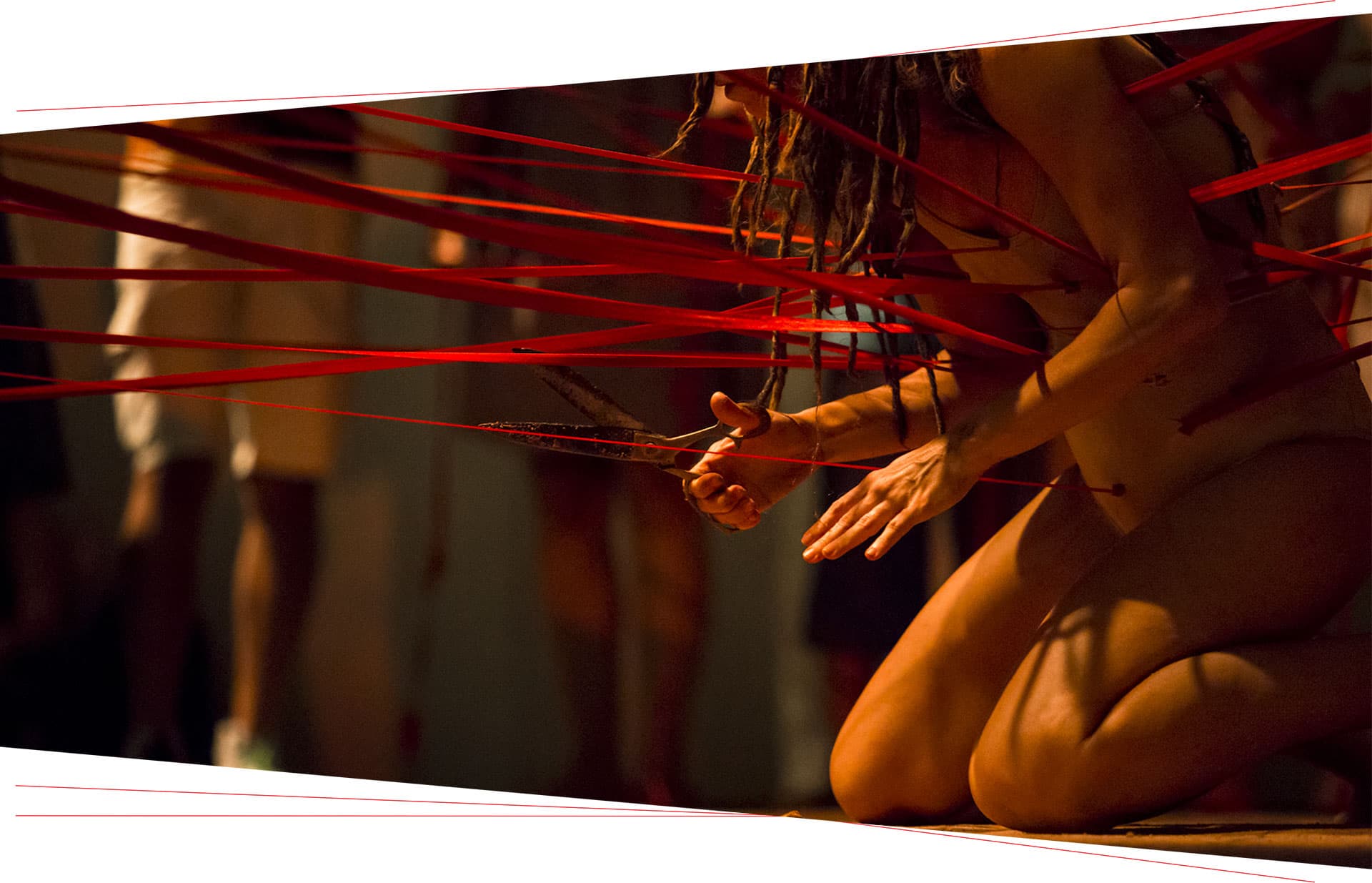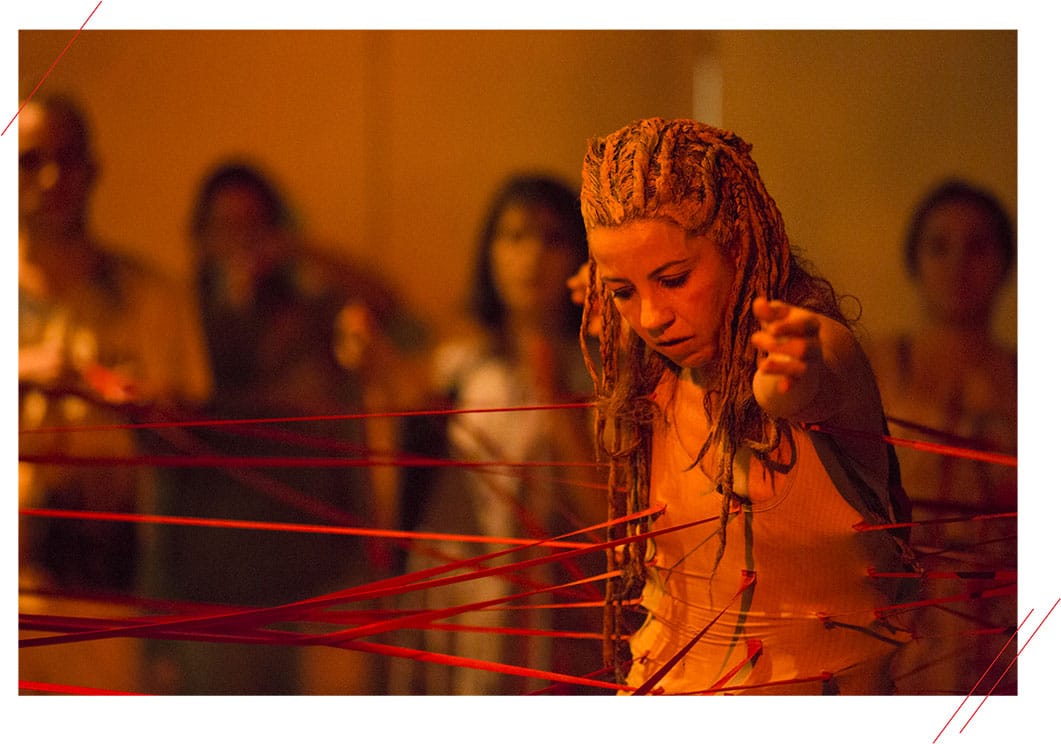Poetic of Pulsion
AnaVitoria presents us a work that, ultimately, questions the possibility of dance. It’s obvious that this questioning wouldn’t make any sense if it wasn’t implemented in the right way; in fact, the risk of failure would exist if the question wasn’t made by someone who has all the necessary means to make it – someone like AnaVitoria, whose trajectory in dance confirms her prominent place in the contemporary dance scene.

The first question discussed in “Pulsão do Laço” is related to space. As she presents us a stationary body, attached to the walls, she engenders the question – there will be dance? How this body – tied to the visible web that apparently hinders her every movement – could dance? We know for sure that somehow there will be dance; nevertheless, the awkwardness aroused by this first moment operates as to denaturalize dance as an act. Typically we would probably be in front of an empty stage, waiting for the show to begin; maybe we could find the body (-ies) motionless, but in a scenery suitable for dance – that means free spaces, open to movement. Here, the situation is different: the body is there, the space is there, but there seems to be an overwhelming tension between them both.

Dancing is only possible after an invitation. “Would you help me dance?”, asks AnaVitória to the audience, beginning thus a double procedure: first, the deconstruction of the space – by the ones who, tearing out of the walls the ribbons that tied down the body, will create the space where dancing is possible; second, the movements negotiation – as the body is subject to strength and action from the ones who detain the ribbons and thus determine the possible gestures. It’s obvious that, under this conditions, dance may or may not be performed: it’s possible that the body turns unable to move, suffocated by extremely close and dominating presences, by restrictive forces, by unavoidable tensions; or, in the opposite case, that dance happens by a conjugation of efforts, generating a harmony conditioned by the multiplicity of unpredictable movements.
AnaVitória’s work aims precisely to an agency of corporal pulsions that, aesthetically arranged, converge to an artistic experience. In this case, the ‘pulsion’ time doesn’t have to be understood in a specific or restrictive sense; it’s enough to rescue its etymological root – the latin verb pulsare, that registers, as possible definitions, ‘to propel’, ‘to expel’, ‘to vibrate’. The poetic of pulsions conceived by AnaVitória are built upon autonomous bodies, whose movements are not subjected to prior request; they have their plain right to movement safeguarded – they should vibrate, they should let their impulses outflow: only on the basis of this fundamental freedom can Ana Vitória deal with the imprevisibility that, entwined to the creative act, creates dance. To the poetic of pulsions, the singularity is essential.
We should observe that even though all of this happens in the physical space, it is in fact the reflex of a process that happens in the cognitive level. As a matter of fact, the negotiation between the bodies mirrors a negotiation of meanings that constitutes dance itself – more than that, it constitutes all art forms as communicative events. To make art possible, the game of senses proposed by the artist must be accepted by the one who is before the artwork: they must somehow engage as participants of the artistic experience, allow to recreate it from their own private repertory of significations. When this doesn’t happen, the incomprehension that blocks sensibility emerges; the art fails to be achieved – either by failure of the artist or by hostility of the audience. On the other hand, when the negotiation succeeds, the art that emerges is a singular experience produced by the complicity between artist and audience. What AnaVitória makes is give concreteness to this exchange that, usually, remains invisible.

However, the breaking point is inevitable. Ana Vitória keeps to herself, secretly, a pair of scissors: which she uses to break the ties, ending the experience she had created on her own. It’s a necessary action, as the return to de daily routine can’t be forever postponed. To interrupt the negotiation doesn’t mean, however, to end the symbolic act: this, internalized by the acting-audience (in an even deeper process, precisely due to the active role that was given to them), remains registered – not only by memory, but also in the body surface, precisely due to the participation in the creating gesture. Once participants of the dance, the body pulsions don’t leave them: they keep repeating them secretly – making the bound that once united them to Ana Vitória eternal.
Henrique Marques-Samyn


Ficha Técnica
Credits
National premiere 2014
Performance Installation by ANA VITÓRIA
Creation, Installation and Performance – Ana Vitória
Light Design – Renato Mangolin
Costume Design – Ana Vitória
Soundtrack organized by Ana Vitória – Jonh Cage, Grupo Anima, Björk and Meredith Monk.
Video Installation – Ana Vitória and Renato Mangolin
Photography – Renato Mangolin
Design – Karin Palhano
Realization – Iroco Produções Artísticas
